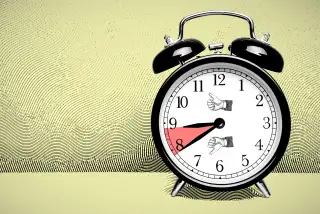Why We Need Daylight Saving Time Year Round

Twice a year, our clocks change for nebulous reasons people don't really understand. And since one of those dates makes people lose sleep and the other one makes people lose daylight, it always brings out some strong opinions.
When people talk about Daylight Saving Time, there's typically casual mentions of farmers, saving energy, and boosting the economy, but half the time people aren't sure what's really at the heart of the biannual time shift.
DST is a bit of a mess, and two potential solutions could be adopted: abolish DST altogether or make it year round. Though both of those might seem like incredibly difficult things, it really wouldn't be. Congress changed the DST dates in 2005 from the first Sunday in April and last Sunday of October to the second Sunday of March and first Sunday of November, and you probably don't even remember. So considering the fact that we have a realistic choice of three options, which is the best?
Option #1: Kill Daylight Saving Time
A ton of people hate DST, and many Internet polls show a vast majority of people hating on it. For the older people who still have telephones to get Rasmussen surveys, DST hate beat DST love by a margin of 43% to 33%.
Pros: The main arguments against DST are that it pointlessly subjects people to stressful, confusing time changes that have been shown to increase workplace accidents and decrease sleep and productivity, which cost our nation $434 million per year.
Cons: The sun would set at earlier times on spring and summer evenings. Retailers say that business is better when the sun shines later into the night—and no one shops in the morning--so DST is good for commerce. That's part of the reason why Congress expanded DST a decade ago. Since people generally do most of their free-time activities after work and not before, we'd be in the dark way more.
(Interestingly, energy consumption doesn't really change when DST is activated, so it's not listed as a pro or a con.)
Option #2: Keep the Status Quo
Sticking with things as they are is always the easiest option, because there is no time or effort required.
Pros: A new law doesn't need to be written. Retailers are happy about having more light in the summer when it's warm. Overall, however, there's a very good reason why people hate Daylight Saving Time—it doesn't seem to have many pros at all, which begs the question, why hasn't Congress called this to a vote yet and changed it?
Cons: The lost sleep, workplace accidents, driving accidents, and productivity, and the impact of all of these factors on the economy. Also the situation illustrated in the video below would keep happening.
Option #3: Make Daylight Saving Time Year-Round
This option is the clear winner, and it seems to be a popular opinion. It'd take all the advantages of abolishing DST, but would allow us to have some sunlight after work instead of before—when we would probably just use it to sleep.
Pros: Most people would get more sleep, which would have a huge benefit, prevent the workplace accidents and car crashes that result from tired people after a time shift. And since cars hurt more people when it's dark, having DST all the time would mean that people would enjoy more light for evening drives, which could decrease accidents and save an estimated 366 lives every year. Farmers wouldn't have to subject cows to an arbitrary change in milking schedule. We'd get more light at a time when we'd more likely use it for something other than sleep.
Cons: Students would have to go to school in the dark (assuming school hours stay the same), and farmers would have to get up really early to get the milk and eggs collected in time for the next steps of the supply chain. "Morning people" (whoever they are) might not like the change all that much.
Which option would you choose?